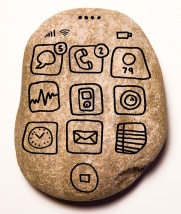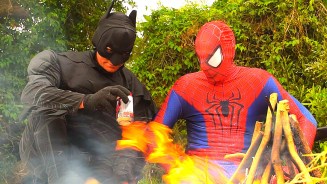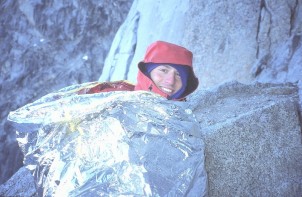How Not to Die in the Woods: 10 Essential Items for Backcountry Adventures
There are countless activities to do in the great outdoors, ranging from the typical hiking and camping to the not so typical cheese rolling and volcano surfing. But whether you are bagging mountain peaks or snorkeling in the bog, you should always be prepared for a “worst-case” scenario.

Uhhh…looks like he is already in the “worst-case scenario”
In the 1930’s, tired of people constantly dying in the wilderness, a Seattle-based club called The Mountaineers put together a list of 10 items necessary for hikers to #1 respond to emergencies on their trips and #2 spend a night or two in the woods if need be. Since then this list has been slightly tweaked a few times to keep up with new technologies and information. But for almost a century it has been a standard for hikers, campers, and backpackers worldwide. Here are the 10 essentials for any outdoor enthusiast, as well as the ones we’ll be bringing on our Appalachian Trail thru-hike:
1. Navigational Tool
Although a map & compass might seem unnecessary with today’s GPS satellites and GoogleMaps on every smartphone, consider this…once your electronic device runs out of battery it’s as good as rock; you can throw it once or twice to scare an animal away, but it sure won’t help you navigate through the woods.

My new phone reminds me to take nothing for granite
On the Appalachian Trail a hiker can’t rely on just the trail blazes for navigation either. Physical blazes may fall off the trees or painted stripes may fade over time. The best option is to take a little compass (learn how to use it BEFORE getting on the trail) and a map or guide book. On our trek we will be bringing the AWOL Guide Book, which is incredibly detailed about the entire length of the AT. Not only does it shows mileage, shelters, and upcoming towns, but also shows elevation gains and losses, best spots for pictures, water sources, state lines, hostels, restaurants, and even where to find a privy! Take that, GoogleMaps!

Siri, where can I go when nature calls?
2. Flashlight/Illumination
Once that ball of fire dips below the horizon each night we mere mortals are left stumbling around in the darkness, stubbing our toes and overthinking those noises coming from behind that tree. That was, of course, until the flashlight was invented huzzah! I mean we still overthink those nighttime noises, but at least we don’t stub our toes anymore.

Not pictured: stub-free toes
There are many options for illumination in the backcountry…the classic flashlight, lanterns, even SmartPhones (beware of the battery!), but for most, a headlamp is the clear choice. It sits on your forehead like a helpful bandanna, leaving your arms free to fight off monsters, or you know, set up a tent, make dinner, hang a bear bag, play cards, etc. The headlamps that we are taking on the trail not only have the typical white light, but also a red light that is easier on the eyes. It will be much easier to make and keep friends when not blinding them on a nightly basis!

Don’t be like Larry
3. Fire
The course of history changed forever when our ancestors learned how to control fire. They could now keep warm, cook food, ward off enemies, and see at night. They could melt metal, build swords, invent engines, and make airplanes fly. Now you can bring fire into the backcountry in the shape of a lighter or some waterproof matches. And it’s super important that you always have one of those tools, because you never know when you might need to make an emergency fire when a freak snow-storm rolls in, or if a buddy gets injured and you need to camp out for a night.

Friends make other friends emergency fires
On the AT we will have a lighter and a handful of waterproof matches. We also are considering bringing some DIY fire starters – cotton balls soaked in Vaseline – for those rainy days when dry kindling isn’t available. Fun fact: Doritos make great firestarters! Watch this video to see how those tasty treats could possibly be life-saving!
4. Sun Protection
The sun has a love/hate relationship with people. It can make you warm, brighten up the world, even boost your mood! But too much can make you sick, burn your skin, or even blind you.

Dirtbag sun
But there are ways that we can protect ourselves from those waves of electromagnetic radiation, whether we are in the wilderness or on the beach…sunscreen and sunglasses! This is one of the 10 essentials because a situation might land you on an exposed peak or out on a river all day, and that sunshine that was once so pleasant can give you serious burns, cause sunstroke, and quicken the rate of dehydration!
Higher elevation means less atmosphere, so there are some spots on the Appalachian Trail that we’ll be exposed to the sun all day. We will be bringing sunscreen with SPF 30. Some of our clothes even have UV protection so we don’t end up getting fried in unexpected places.

5. Emergency Shelter
For the thru-hike of the AT, we will have a tent as our shelter, but for shorter trips an emergency shelter is key to survival. Think of a worst-case scenario…the sun is about to set and you’ve been wandering around trying to find the trail (because you forgot your map & compass) and now you’re lost. You’re going to have to set up camp in the woods and wait until the morning comes to continue finding the path. There’s not much kindling on the ground, and you ate all your Doritos, so your fire is small (or nonexistent). You can feel your body temperature dropping. But aha! You pull out your emergency blanket and huddle under it, letting your body warmth reflect and stay trapped under the material. You will survive the night!

An emergency blanket is small, lightweight, very packable, and could save your life. And on the plus side, you get to look and feel like a burrito!

I’ll never be able to look at Chipotle the same way again
6. First Aid Kit
Ok, so this one is pretty obvious, but it doesn’t hurt to get a reminder! The kit doesn’t have to be the size of a doctor’s bag, but should have the essentials for outdoor medical situations. Bandaids for cuts/scrapes, moleskin for blisters, Ibuprofen for aches/pains, alcohol swabs for cleaning injury sites, and antibiotic ointment for preventing infection are the important pieces. Other bits that we’ll be taking on the AT: disposable gloves, tweezers, first-aid tape, burn gel, Sting-Eze, and safety pins.
And it’s worth mentioning that a first-aid kit is not only helpful for you if you get sick or injured while in the backcountry, but also for another person you encounter who may need your help. Alternatively you could bring a doctor on your trip with you.

Ummm, not exactly the Doctor I had in mind…
7. Insulated Clothes
Your first line of defense against the elements is your clothing, which is why it makes the list of essentials. It’s important to be prepared for all types of weather, because Mother Nature is as wild and unpredictable as a candy store full of unsupervised children.

Just stay out of the way and let them run their course
Any person headed on a wilderness adventure for a day or for 5 months knows that COTTON KILLS! Don’t wear cotton anything, not even underwear! When insulating, start with a base layer made with wool to wick the moisture away from your skin. The mid-layer could be wool, down, fleece, or synthetic which helps regulate body temperature and keep you warm. And the shell layer should be protective against weather, so think water-proof and tear-resistant material like Gore-Tex. And although it’s not necessary, I always like to carry an extra pair of dry socks. They are like mini-morale boosters after a day of cold, wet feet.

Yay, dry feet!
8. Repair Kit/Tools
If the situation calls for you having to build an impromptu shelter or fix a hole in your tent, a few tools will be very much appreciated by you. I’m talking about a knife, needle/thread, duck tape, paracord, and repair patches. These items, and a little creativity, can go a long way to helping you survive a worst-case scenario.
On the AT, we will be bringing all of the above (in minimalist quantities). This will keep our pack weights down, but give us ease of mind knowing we are prepared when things go wrong!

I don’t care how much it weighs, it’s NECESSARY!
9. Nutrition
Just in case you’ll be spending a surprise extra-night in the backcountry it’s a good idea to take some emergency food with you. It should be light enough to not weigh you down, but should have enough calories to give you energy for survival.

A daily emergency in our apartment
On the AT our emergency food will likely be trail mix and protein bars, as they are small and compact, yet full of carbs, proteins, and fats. Snickers bars will likely also do the trick!
10. Hydration
Water should be the number one priority when venturing into the outdoors. I mean, we essentially are bags of water with a few bones and organs thrown in there, so it’s super important to maintain a hydrated body. Especially when there is physical activity involved like hiking, kayaking, biking, or beer pong! If you go 5 days without water, chances are you won’t make it to the 6th day, so make sure to have a way to get hydration in the wilderness.
On our AT trek, we are bringing water filters (Sawyer Squeeze & Platypus Gravity) that will allow us to drink from even the most grossly stagnant ponds. It won’t taste amazing, but at least it will keep us going to find better water sources. Fingers crossed for crisply cold and swiftly moving mountain streams the whole way!

On Instagram it might be cool, but not in the backcountry!
And there you have it…the 10 Essentials.
Other items to consider would be insect repellent, a whistle, personal hygiene equipment, a bear bag, and rope. While not wholly necessary, they are good things to have on an outdoor excursion.
And lastly, knowledge. All of these items won’t do you any good if you don’t know how to utilize them properly! Before venturing off it’s a good idea to do some research about where you are going, check the weather forecast, tell a friend where you are headed, and when you plan on returning.
And then when you think you are finally ready, watch The Lion King to be traumatized reminded of this valuable lesson from the evil lion, Scar:

Are you done crying? Ok good!! Now get out there and (safely) enjoy the great outdoors!
This website contains affiliate links, which means The Trek may receive a percentage of any product or service you purchase using the links in the articles or advertisements. The buyer pays the same price as they would otherwise, and your purchase helps to support The Trek's ongoing goal to serve you quality backpacking advice and information. Thanks for your support!
To learn more, please visit the About This Site page.


Comments 2
Great article. One thing I would say about sun protection, there are great options now for thin UV protecting clothing. I haven’t done a thru hike yet, but spend a lot of time outdoors. After getting skin cancer, leaving a 4 inch long scar on my neck, at only 22 years old, I’ve become a lot more mindful of the sun in the following years. I use columbia pants and long sleeve shirts, like the fishing style ones, and a big hat. There are other brands, just throwing that one out there. They’ve come a long way in terms of comfort the past few years as well. I’ve never liked sun screen and it needs to be reapplied so often, especially when wet or sweaty, that it loses its value really quickly.
Happy Hiking!
Jarrod